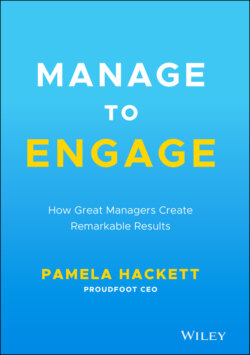Читать книгу Manage to Engage - Pamela Hackett - Страница 39
Soul-Destroying Survey Findings
ОглавлениеLet's step back in time for a moment. In 2003, Proudfoot released the results of its Global Organization Assessment Survey.4 At the time I was president of the firm's People Solutions practice, so I led the compilation of these surveys and saw the results firsthand. They were anything but encouraging. Combining the responses of over 5,000 people surveyed at the launch of their change programs, from a range of industries, the survey's top-line findings highlighted a startling trend that transcended national boundaries: a global, fundamental development need to address our ability to engage people. When the same survey was conducted seven years later, Proudfoot saw much the same results. Fast forward another seven years, and although some of the survey questions had now been modernized to unpack what people needed to better engage in business, the results were still dire.
The 2018 research confirmed five things:
1 Changes at work are not managed smoothly. This was the conclusion of three-quarters of the 2018 survey participants. Organizations were clearly failing to prepare people for – and execute – change. Respondents certainly saw the need for change, but less than 40 percent were confident this would happen. Even relatively straightforward changes to processes or procedures – the fundamental building blocks of any company – were a bumpy ride (just 28 percent said these went smoothly). If we can't get things right at the process level, what hope is there at an organizational level?
2 The billions spent on infrastructure were not working for people. Despite the billions invested worldwide in process improvement, technology, and HR, and in systems to report information and enhance communication between people, the research suggested these were not having the desired impact. Half reported they did not have the skills and knowledge they needed to continually improve their performance. Organizations had focused too much on implementing technology and not enough on the impact on people or enabling them to use the technology. Worse still, they had not engaged people in the technology changes early or often.
3 Communication was still ineffective. “The many” saw communication (external and internal) continuing to need dramatic improvement. From the 1970s, when communication was first ranked highly on the list of “change disarmers” to 2018, surveys found our ability to communicate information effectively throughout an organization was poor. In many organizations, nothing had changed. Without great communication, how could you possibly engage? Without understanding the role communication has in building employee confidence, you would not engage.
4 It is a two-way street. Almost two-thirds of mid-level managers saw a lack of input from “the many” in strategic priorities. Participation was absent. Too often we still operated in a top-down world. The few dictate the future of the many; people removed from the guts of the company were deciding the business's future. Decision-making was hampered by overly complex processes and a lack of freedom to make and act on decisions, and more than half believed getting things done depended more on who rather than what you knew.
5 80 percent of people lacked faith in leadership. Further supporting the finding that lower tiers of employees too often feel left out of the loop, survey respondents generally felt leaders’ communication effectiveness to be poor, while a third couldn't confidently say that their immediate superiors were preparing their organization effectively for the future. This dismal result is depressing for management teams, to be sure.
The surveys continued to tell us, we'd yet to get it right. The many were still managed by the few, and most were pretty rankled by it. This was a people crisis 100 years in the making, from the time modern management was born. Alexander Proudfoot saw the same issues in 1946 when he founded Proudfoot to address these concerns. As a McKinsey consultant, he felt it was time to move from strategy consulting to implementation consulting – how to get the many on board with the few. The difference this time round (postpandemic) is the urgency needed to address it. Unless we do things differently now, this people crisis will slow the recovery of future economic recessions and crisis, and revisit us with monotonous regularity. Huge proportions of our working populations will mentally and emotionally shut down.
